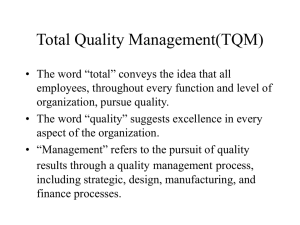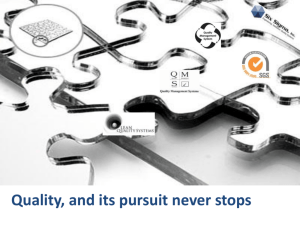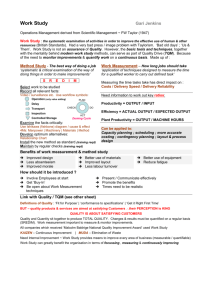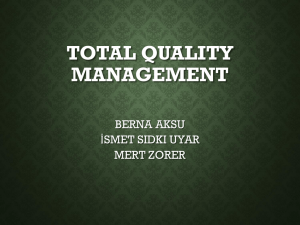What Is Quality
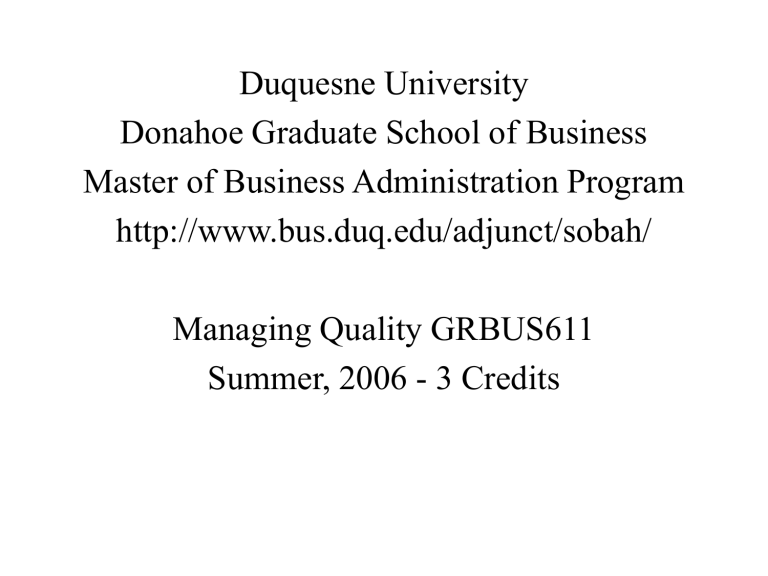
Duquesne University
Donahoe Graduate School of Business
Master of Business Administration Program http://www.bus.duq.edu/adjunct/sobah/
Managing Quality GRBUS611
Summer, 2006 - 3 Credits
Instructor: Hank Sobah
Business Phone: 412.937.7687
Business Fax: 412.937.9309
Email: hsobah@innovativesystems.com
Office hours: Prior to class, after class, or
Schedule: by appointment
Thursdays, 6:00 p.m. – 9:20 p.m.
May 11, 2005 – July 27, 2006
Room 501 Rockwell Hall
GRBUS611 Managing Quality
• This course is designed to provide a basic understanding of the philosophy, tools and framework involved in implementing a formal
Quality Management system.
• Theories, tools, practices and application
• Students will be exposed to the evolution of Quality
Practices and Principles, related quality and performance management systems, the teachings of
W. Edwards Deming, Six Sigma and other organizational change strategies related to quality.
GRBUS611
• The Malcolm Baldrige National Quality
Award (MBNQA) and various regional and state quality recognition criteria will be emphasized, studied and discussed. Case studies of organizations who have successfully implemented the techniques will be used to enhance the classroom discussions
GRBUS611
• Tools and techniques used in TQM settings will be introduced.
• Class projects will be used to emphasize the
Malcolm Baldrige National Award for
Performance Excellence and various other processes involved in Quality Improvement.
Learning Objectives
•
Discuss characteristics of a High Quality organization
• Identify the role of TQM with regard to an organization’s effectiveness
• Identify Leadership’s role in designing and implementing quality initiatives
• Discuss Deming’s 14 points, Shewharts Plan/Do/Check/Act cycle, Crosby’s concept that Quality Is Free
• Describe how an organization’s mission, vision, values and
Quality Management approach influence employees, customers, products, services, processes and organizational performance
•
Apply a framework for quality improvement in a practical setting
•
Apply the theory of variation to work processes
•
Build a measurement approach into the management of the organization
•
Apply common sense Quality tools in the work setting
Learning Methodologies
•
Use books, ISO9000 Standard and the
MBNQA criteria to create a foundation
•
Read current articles to provide us with a
“Today and Future” perspective
•
Read and discuss case studies to integrate the knowledge obtained
•
Participate in team assignments
•
Design a TQM project
Required Text
• The Quality Improvement Handbook. ASQ Quality
Management Division, John Bauer, Grace Duffy, et.al.
•
2005 Criteria for Performance Excellence (for
Business). National Institute of Standards and
Technology, U.S. Department of Commerce - can be downloaded from: www.nist.gov (or directly at http://baldrige.nist.gov/Business_Criteria.htm )
•
Who Moved my Cheese? Spencer Johnson, M.D.,
New York: G.P. Putnam’s Sons 1998 --www.whomovedmycheese.com
Optional Reading
•
Quality is Free. Philip B. Crosby, New York: New American
Library 1979 --- The Philip Crosby Institute
•
Juran on Leadership for Quality. Joseph Juran, New York:
Free Press 1988 --- The Juran Institute
• The Certified Quality Manager Body of Knowledge
, American
Society for Quality
• The Quality Book CQM Review. Greg Hutchins, Portland OR:
1996 --- ASQ Quality Management Division --- ASQ Human
Development and Leadership Division --- ASQ Pittsburgh
Section
• ISO 9000 Preparing for Registration. James Lamprecht,
Milwaukee, WI: Quality Press 1992 --- ASQ on Standards ---
ISO 9000 and Related Standards
•
Six Sigma, Harry, Mikel, Ph.D, and Shroeder, Richard, New
York: Currency 2000 – 6 Sigma Academy
Course Perfomance/Evaluations
•
Mid-term and final exams = 45%. The exams will consist of true/false, multiple choice, completion and essay questions. NO MAKE UP EXAMS
•
Project = 35%. Specific details will be provided under a separate cover.
•
Participation and attendance = 20% :
•
In class, I will apply a variety of different approaches (study questions, debates, team assignments) to make the class a true learning experience but you have to be there to benefit from the experience
• Any student missing 1/3 or more of the classes will be asked to withdraw or given an F
• Each class is work 1.6666 points. For each class missed, these points will be deducted from the participation and attendance category of your grade.
• 12 classes attended and participated / 12 total classes = 1 x .20 = 20%
(total points awarded)
•
9 classes attended and participated / 12 total classes = .75 x .20 = 15%
(total points awarded)
• Points will also be deducted for students arriving for class late or leaving class before the class is over
B-
C+
C
F
A
A-
B+
B
GRADING
80
77
70
69
93
90
87
83
- 100
- 92
- 89
- 86
- 82
- 79
- 76 and below
ADDITIONAL NOTES
• During the semester, additional readings and class work will be assigned at the instructor’s discretion.
•
Any students who have special needs, please see either instructor at the end of the second class to discuss arrangements - May 18th.
•
Any students who have circumstances that will impact their attendance and/or punctuality, please see either instructor at the end of the second class - May 18th.
Class #1
5/11/2006
Class #2
5/18/2006
Class #3
5/25/2006
Class #4
6/1/2006
Class #5
6/8/2006
Class #6
6/15/2006
Planned Course Outline
Introductions, Course Description, Review of Syllabus
“What is quality anyway?” Classroom Presentation, Discussion
Quality as a change strategy - Who Moved my Cheese
Reprint, Corporate Change Article
Quality Basics – The Quality Improvement Handbook, Handout -
Overview of Terms, Concepts and Principles
Teaming for Quality Improvement
– The Quality Improvement
Handbook, Handouts, Discussion - “Talking the Talk and
Walking the walk along the yellow brick road to quality.”
Deming – Crosby Juran – Theory - “If you have an idea, hold on to it for a few years – it will catch on!”
MBNQA Stock Performance – NIST
Deming – Finish
Tools of Quality - 14 Points, 7 Deadly Sins, Manage the System
Profound Knowledge Mid-Term Review – Class Projects Free
Time “ What do I need to know.
. .”
Part I
Mid Term Exam / Presentations - “Whaddaya know.”
Class #7
6/22/2006
Class #8
6/29/2006
Class #9
7/06/2006
Class #10
7/13/2006
Class #11
7/20/2006
Class #12
7/27/2006
Planned Course Outline
Other Quality Philosophies - Baldrige – “If you do it right the first time, they will come and you will be rewarded greatly”
ISO9000 –
“Systematic management of quality standards and systems”
Six Sigma - “The best job is when you can wear a cowboy hat to work.”
Part II , Continuous Improvement, Kaizen, Kan-Ban, ISO9000 vs Six Sigma vs Baldrige
MBNQA Framework
MBNQA –, Leadership, Strategic Planning, Human Resources,
“You can’t do it without them”
MBNQA – Business Results, Customer and Market Focus
“Remember who pays the bills...if you can’t measure it, it wasn’t done.”
MBNQA Measurement Analysis and Knowledge Management, Process
Management -
“Defining the requirements and by the way, what should we do with all of this data that we have been collecting?”
Final Exam / Projects Due – Discussion “So what is quality anyway.”
Final Exam / Project Review – More Discussion “So what have we learned.”
Managing Quality
What is Quality Anyway?
Instructor: Hank Sobah
What Is Quality?
Quality is
…past
…present
…future
Quality
• Quality in Fact
• Quality in Perception
History of Quality
•
Guilds of Medieval Europe From the end of the 13th century to the early 19th century, craftsmen across medieval Europe organized into unions called guilds.
•
Product Orientation quality practices in the
1800s were shaped by several different production methods:
– Craftsmanship
– The factory system
– The Taylor system
History of Quality
•
Craftsmanship
In the early 19th century, the approach to manufacturing in the United States tended to follow the craftsmanship model used in the European countries. In this model, young boys learned a skilled trade from a master while serving as his apprentice
History of Quality
• The factory system 19 th Century
Created by the Industrial Revolution in Europe, subdivided craftsmen’s trades into multiple specialized tasks.
Forced craftsmen to become factory workers and shop owners to become production supervisors.
Marked an initial decline in employees’ sense of power and autonomy in the workplace.
Quality in the factory system was ensured through skilled laborers and supplemented by audits and/or inspections.
History of Quality
•
The Taylor system
Late 19th century, US broke from European tradition and adopted a new management approach developed by Frederick W. Taylor.
Goal was to increase productivity without increasing the number of skilled craftsmen.
Achieved by assigning factory planning to specialized engineers and using displaced workers and supervisors to execute the engineers’ plans.
History of Quality
• Process Orientation began in the 20th century marked the inclusion of processes in quality practices.
• Dr. Walter Shewhart, began to focus on controlling processes in the mid-1920s.
• Shewhart recognized that industrial processes yield data. For example;
– A process in which metal is cut into sheets yields certain measurements: the sheet’s length, height, weight, etc.
• Invented Statistical Process Control
History of Quality
• Birth of total quality in the US was a direct response to the quality revolution in Japan following World War II.
History of Quality
The Japanese quality revolution
* After the war, major Japanese manufacturers converted from producing military goods for internal use to civilian goods for trade.
* Japan’s reputation for shoddy exports preceded the products, and they were subsequently shunned by international markets.
* Japanese organizations explored new ways of thinking about quality.
* They welcomed input from foreign companies and lecturers, including American quality experts W. Edwards Deming and
Joseph M. Juran
* The adopted unprecedented strategies for creating a revolution in quality.
History of Quality
• Japan’s strategies represented the new “total quality” approach.
• Their total quality approach focused on improving all organizational processes instead of inspection
• Japan was able to produce higher-quality exports at a lower price.
• Consumers throughout the world benefited from this quality breakthrough.
History of Quality
• In June 1966, American quality expert
Joseph M. Juran predicted:
“The Japanese are headed for world quality leadership and will attain it in the next two decades because no one else is moving there at the same pace.”
History of Quality
• Japanese manufacturers began increasing their share in American markets, causing widespread effects in the United States:
• Manufacturers began losing market share,
• Organizations began shipping jobs overseas,
• The U.S. economy suffered unfavorable trade balances as a result.
• Overall, the impact on American business jolted the United States into action.
History of Quality
The American response
At first, the U.S. clung to its assumption that Japanese success was price-related and responded with strategies aimed at reducing domestic production costs and restricting imports. This, of course, did nothing to improve American competitiveness in quality.
History of Quality:
As time went by;
• Price competition declined while quality competition continued to increase.
• By the end of the 1970s, the American quality crisis reached major proportions.
• It attracted attention from national legislators, administrators, and the media. An NBC News white paper entitled “If Japan
Can . . . Why Can’t We?” highlighted how Japan had captured the world auto and electronics markets by following Deming’s advice of revolutionary improvements.
• Finally, American organizations began to listen. Several initiatives followed as the United States got up to speed on quality.
1940’s
W.Edwards
Deming
TQM
1950’s
Joseph
Juran,
TQM
1970’s
Emphasis on Quality
Assurance
1980’s
Malcolm Baldrige
National Quality
Award
MBNQA
TQM
2000
Six-Sigma
1930’s
Walter
Shewhart
SPC
1970’s
Philip
Crosby
Quality is
Free COPQ
1990’s
Re-engineering
ISO, CMM,
Value Creation
Future
???
Comparison of QA and TQM
- Traditional QA
Leadership may not have been invested
Problem solving by
Authority
Aimed at meeting imposed standards
Isolated
- Progressive TQM
Leadership actively leading
Problem solving by staff at all levels
Aimed at meeting and exceeding customer needs and expectations
Continuous
Comparison of QA and TQM
- Traditional QA
Inspection oriented
(detection based)
Reactive
Correction of individual causes / symptoms
Responsibility of few
“Quick Fix” mentality
- Progressive TQM
Planning oriented
(preventative)
Proactive
Correction of Common
Causes / Root Cause
Responsibility of many
Process Oriented and
Systematic
Weaknesses of Traditional QA
• Largely driven by external requirements
• Department Focused rather than Process
Focused
• Focus on individuals, not processes
• Emphasis is on thresholds – Acceptable
Quality Levels (AQL), Average Outgoing
Quality Levels (AOQL), etc.
How good is good enough?
99% Acceptable Quality Levels
• For every 300,000 letters delivered.3,000 misdeliveries
• Out of every 500,000 computer restarts 5,000 crashed systems
• For 500 years of month-end closings 60 months would not balance
• For every week of TV broadcasting
(per channel1.68 hours of dead air
1.8 seconds of dead air
How good is good enough?
99% Acceptable Quality Levels
• At least 200,000 wrong drug prescriptions each year.
• Two short or long landings at major airports each day.
• 5,000 incorrect surgical procedures every week.
• 20,000 lost articles of mail per hour.
• No electricity for almost seven hours each month.
• 50 dropped newborn babies each day.
How good is good enough?
How about 99.9% Acceptable Quality Levels
• Your heart would not beat for 8.8 hours per year
• 15,000 newborn babies would be dropped on their heads each year in hospitals
• 500 Incorrect surgeries would be performed each week
• 13,699 unsafe cans of soda would be consumed every day
• A manufacturing process with 500 people would produce the correct product 61% of the time
How good is good enough?
OK then, isn’t 3 sigma better - Is 3 Sigma good enough?
• US Postal service:
– 3 Sigma: 20,000 lost articles of mail/hour
• Airplane Landings:
– 3 Sigma: 2 short/long landings every day
• Drug prescriptions:
– 3 Sigma: 200,000 wrong drug prescriptions/year.
• Unsafe drinking water almost 15 minutes each day.
• No electricity for almost seven hours each month.
• 5,000 incorrect surgical operations /week
How good is good enough?
Hmm, then what is good?
• One Sigma = 170 misspelled words per page in a book
• Two Sigma = 25 misspelled words per page in a book
• Three Sigma = 1.5 misspelled words per page in a book
• Four Sigma = 1 misspelled word in 300 pages
• Five Sigma = 1 misspelled word in the
Encyclopedia Britannica
• Six Sigma = 1 misspelled word in all the books in a city library
What is TQM?
• Plain and simple:
- Doing the right things right the first time
TQM Defined
• A science that accomplishes quality goals with an organization wide commitment and dedication to continuous improvement in customer satisfaction through the effective utilization of human resources, a focus on process and outcome, management by fact, and a senior management that is highly visible and engaged.
Benefits of TQM
• Satisfies customers
• Enthuses employees
• Teams suppliers
• Comforts investors
• Pleases the public
Barriers to TQM
• Complacency
• Resistance to change
• Rigid or Outdated Standards (AQL, EOQ)
• Time
• NOTE – TQM is not an assignable task. It must be rooted and institutionalized within every step of the business process – it is everyone’s responsibility!
The TQM Approach
• Analytical
• Based on Continuous
Improvement
• Data and Fact based
• Involves Everyone
• Customer/Supplier
Relationship
• Leadership Driven
• Proactive,
Preventative
• Process Focused
• Team Oriented
• Addresses Vital
Processes
• Seeks out Root Causes
Quality Management
Theorists in Industry
• Walter Shewhart
– Father of Statistical Process Control
• W. Edwards Deming
– Management and Leadership Oriented
– Customer Focused
• Dr. Joseph P. Juran
– Focus on Effective Process Control
• Philip Crosby
– Quality is Free
– Cost of Poor Quality
W. Edwards Deming
“The consumer is the most important part of the production line.”
• Probably the most significant quality leader of the 20 th century
• Focus on Leadership
• Focus on the Customer’s Needs and
Expectations
• 14 Points
• 7 Deadly Diseases
Cycle for Improvement
AKA Shewhart Cycle
• Plan
– Determine how an issue or potential improvement will be studied (what data to collect to answer a defined question)
• Do
– Implement plan on a small scale
• Check
– Check the data and analyze results – evaluate the effect of an action
• Act
– Implement action or improvement and continue process for further improvement
At Toyota – ask why 5 times!
An example of getting to the root cause:
-
Why did the fuse blow?
Because the bearing was overloaded.
Why was the bearing overloaded?
Because it was not lubricated.
- Why was the bearing not lubricated?
Because the lubrication pump was not working properly.
- Why was the pump not working properly?
Because the shaft was worn.
- Why was the shaft worn?
Because there was no strainer and scraps of metal got in.
In D.C. – ask why 5 times!
Another example of getting to the root cause:
-
Why was the marble sugaring on the Lincoln and Jefferson
Memorials?
Because they were washed so frequently
- Why were they washed so often?
Because the birds left so many droppings
- Why are there so many birds at the memorials?
Because the sparrows and swallows gather there to eat all of the spiders
- Why are there so many spiders?
Because the spiders like to eat the midges
- Why are there so many midges?
Because the lights, when turned on at dusk, attract swarming midges
SOLUTION – Turn the lights on an hour earlier
Quality Management’s
“Common Language
”
• Quality
• Process
• Customer
• Teams
• Continuous
Improvement
Words
• Requirements
• Process Improvement
• Leadership
• Training
• Root Cause Fixes
• Voice of the Customer
Central Tenet
• Quality is achievable
• Focus on Process not People
• Identify Customers – Big C, little c
• Define requirements
• Eliminate Variation
• Everyone’s Responsibility, Top Down
